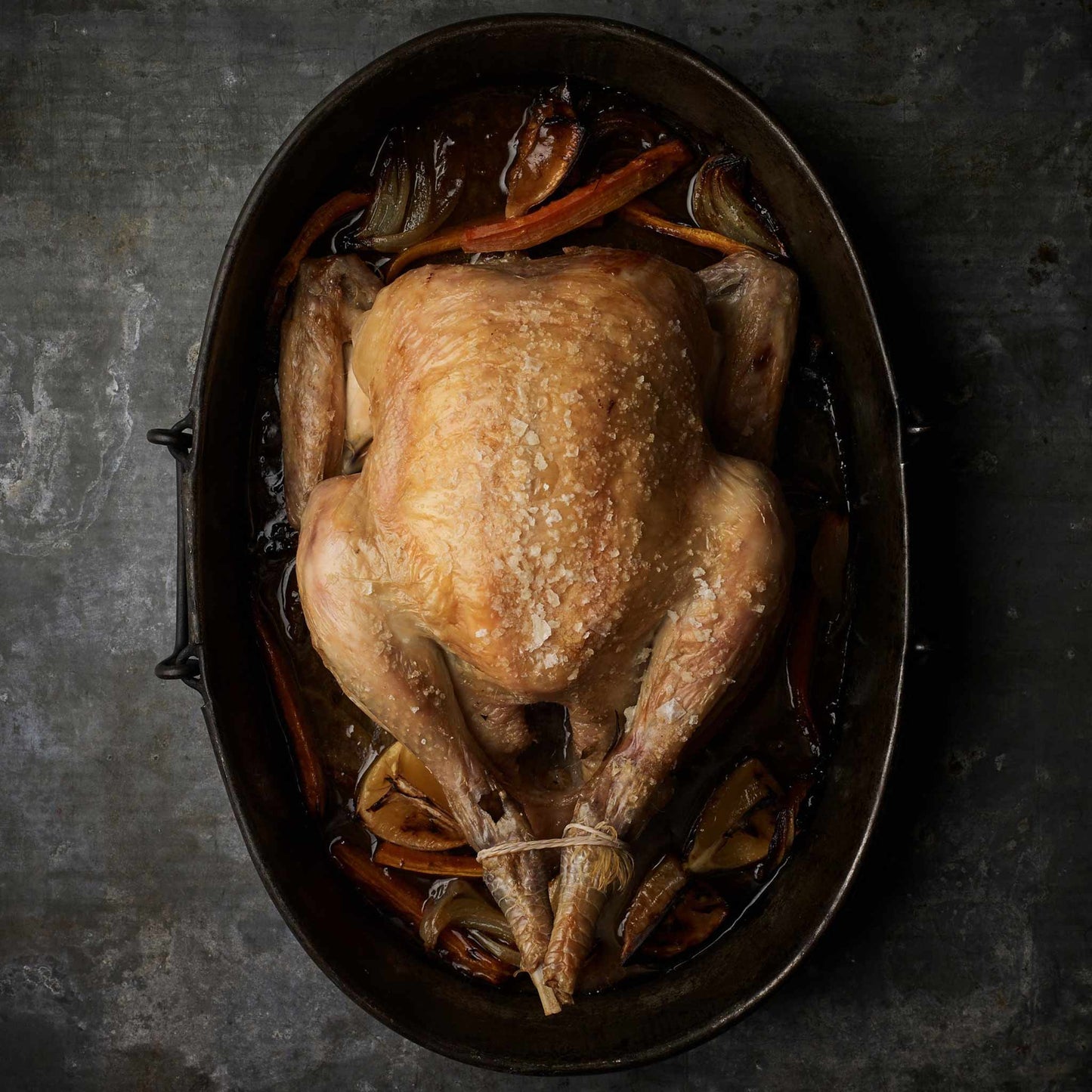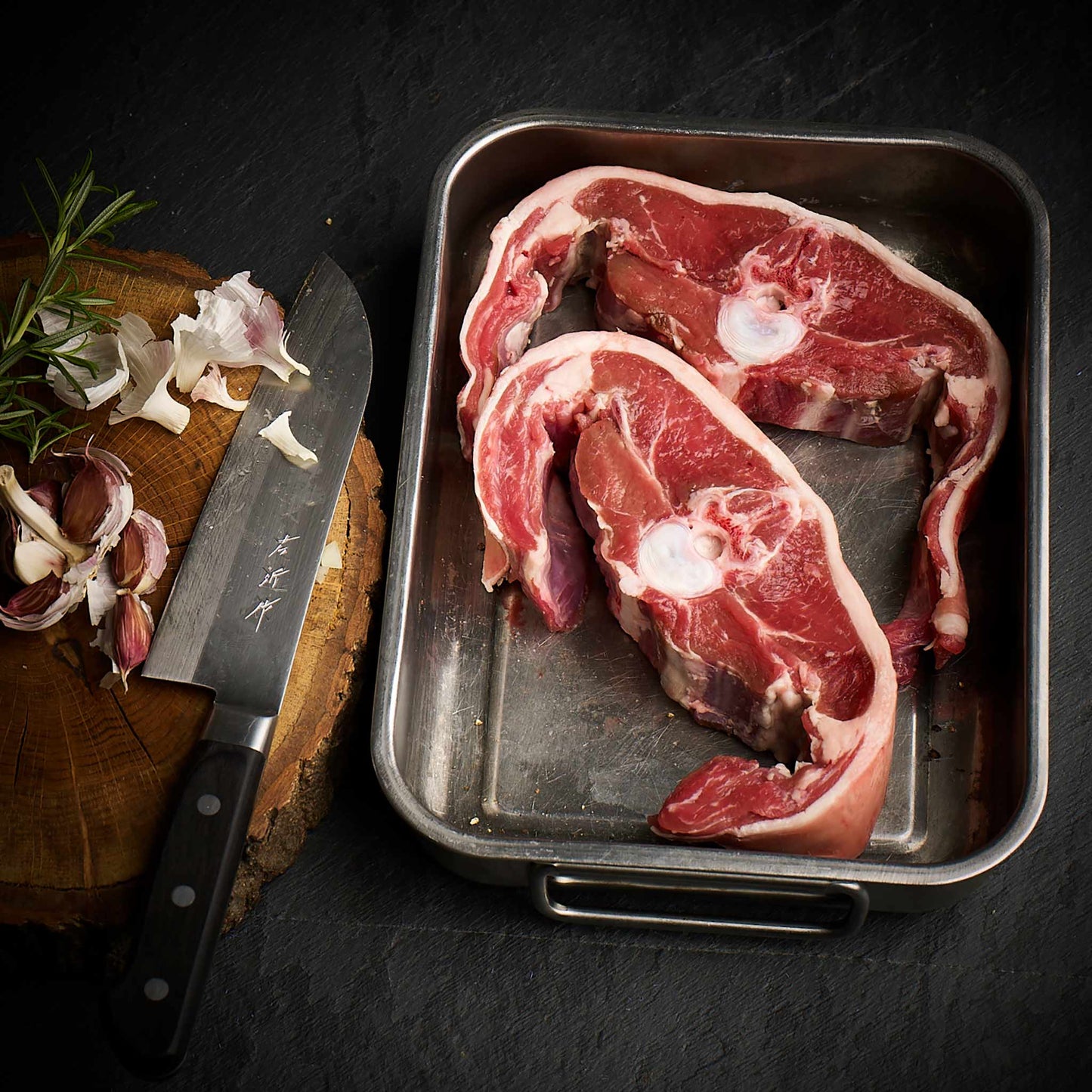We source our chicken from one farm in Leicestershire. The farm is Pasture for Life certified and rears truly free range, outdoor birds.

There's a lot of talk about superfoods these days; we're always hearing about some new Himalayan berry that unlocks eternal life. But there is a true superfood that our ancestors knew well, but which has almost become a waste product because we have forgotten how to cook it and lost our taste for it. This superfood is, of course, beef liver.
Why haven't we been stocking it until now?
We have wanted to stock beef organs since we founded the business but logistics have made that difficult.
The problem is that muscle meats are aged for 3 weeks before we take delivery. The abattoirs we work with age the carcass and deliver to us when it's ready for cutting. Organs on the other hand are best consumed very fresh – certainly not 3 weeks old!
As we have scaled up we're buying more regularly from our supplier Neil Harley, who is delivering the dry-aged carcass to us on the same day that other animals are taken to the abattoir, meaning we can get the organ meats the next day. This is as it should be: very fresh, not frozen, and full of nutrition.
Now we're able to sell beef liver, we have decided to only sell it as fresh as it can be. We ship the day after we receive it, once every two weeks, and we doubt you can find fresher anywhere. To stay in the loop with shipping dates, please use the 'notify me' button on the product page here.
What's so great about liver?
Liver is a nutritional powerhouse. We sell our beef liver in 120g portions, and just 100g provides:
Vitamin B12: 3,460% of the RDI. Vitamin B12 helps the formation of red blood cells and DNA. It is also involved in healthy brain function.
Vitamin A: 860–1,100% of the RDI. Vitamin A is important for normal vision, immune function and reproduction. It also helps organs like the heart and kidneys function properly.
Riboflavin (B2): 210–260% of the RDI. Riboflavin is important for cellular development and function. It also helps turn food into energy.
Folate (B9): 65% of the RDI. Folate is an essential nutrient that plays a role in cell growth and the formation of DNA.
Iron: 80% of the RDI, or 35% for women of menstruating age. Iron is another essential nutrient that helps carry oxygen around the body. The iron in liver is heme iron, the kind most easily absorbed by the body.
Copper: 1,620% of the RDI. Copper acts like a key to activate a number of enzymes, which then help regulate energy production, iron metabolism and brain function.
Choline: Liver provides all of the Adequate Intake (AI) for women and nearly all of it for men (AI is used because there is insufficient evidence to set an RDI). Choline is important for brain development and liver function
Liver was and is highly prized by indigenous communities
In times past the organ meats were more highly prized than the muscle meats we now favour and in many indigenous communities the liver was eaten by those who needed the nutrition the most: pregnant women and children. Otherwise it was eaten by the chief of the tribe before the commoners got any!
Below amended from https://carnivoreaurelius.com/
#1 West Nile Tribes
Dr. Weston Price traveled throughout Africa in the 1930s to examine dental health. He noticed that Tribes in Africa still eating primitive diets had little to no signs of tooth decay and beautiful teeth.
Meanwhile the United States counterparts were ridden with issues.
I envy these children who didn’t need head gear or rubberbands for all that time…
According to Dr. Price, the children of the west Nile were highly immune to dental caries and were physically very healthy. The women were over 6 ft tall and many men were over 7 ft.
The people at the Nile prized liver as a sacred obsession:
I learned that they have a belief which to them is their religion, namely, that every man and woman has a soul which resides in the liver and that a man’s character and physical growth depend upon how well he feeds that soul by eating the livers of animals. The liver is so sacred that it may not be touched by human hands. It is accordingly always handled with their spear or saber, or with specially prepared forked sticks. It is eaten both raw and cooked — Dr. Weston Price
#2 Outer Herbides
Tribes in the Outer Herbides exhibited a similar immunity. One of their dietary staples was a dish consisting of cod’s liver and cod’s head.
“This diet, which included a liberal supply of fish, included also the use of livers of fish. One important fish dish was baked cod’s head that had been stuffed with oat meal and chopped cods’ livers. This was an important inclusion in the diets of the growing children. The oats and fish, including livers, provided minerals and vitamins adequate for an excellent racial stock with high immunity to tooth decay.”
#3 Comanche
The Comanche were one of the most powerful American Indian tribes in history. Their diet consisted largely of buffalo and meat.
The Children of the Comanche were obsessed with liver.
“Children would rush up to a freshly killed animal, begging for its liver and gallbladder. They would then squirt the salty bile from the gallbladder onto the liver and eat it on the spot, warm and dripping blood.”
#4 Native Americans
Some other notable accounts of native American’s eating liver existed.
In The Ways of My Grandmothers, Beverly Wolf describes how they’d prepare the entire cow, nose to tail to be eaten. The liver, of course, was important:
“All the insides, such as heart, kidneys and liver, were prepared and eaten, roasted or baked or laid out in the sun to dry. The lungs were not cooked”
Other Native Americans, called Mountain Men here, prized the liver even over the meat of the Buffalo. The lean meat was often discarded and left to scavengers, while the mountain men prized the fats and organ meats for themselves.
“When game was plentiful, however, only a few choice parts were taken, and the vast bulk of the meat was left to scavengers. The small and large humps were usually taken first….The tongue was removed by “ripping open the skin of the lower jawbone and pulling it out through the oriface. The heart and liver were added to the fare.”
When deprived of food for an extended period of time, Mountain Men would go straight for the liver and organs. They didn’t show much table manners either:
“When mountain men had been without meat for several days before slaying a buffalo, all traces of Anglo-Saxon civilization vanished instantly. The liver was torn from the body cavity. Bloody and unwashed, it was seasoned with gunpowder, or by squeezing the gall bladder’s contents over it, and then consumed without further preparation.”
#5 Inuit
Many carnivores have the false belief that the inuit avoid organs, just because Viljamurr Stefansson suggested that. However, there’s copious evidence that manl other inuit groups prized liver.
Additionally, according to Vilhamurr Stefansson, ““The groups that depend on the blubber animals are the most fortunate, in the hunting way of life, for they never suffer from fat-hunger”
Blubber contains substantial amounts of vitamin A and fat soluble vitamins, thus they may have been getting these needs elsewhere. If you’re avoiding liver just because Stefansson did, be careful unless you’re eating blubber. (If you are, please send me some).
The most comprehensive study of the Inuit found extensive variety in their food consumption:
“This included ringed seal meat, blubber, liver, flippers, heart, brain, eyes, intestine, ear, tongue, lungs, blood and stomach, bearded seal meat, blubber and intestines, narwhal and walrus meat, liver, heart, blubber, mattak, flippers and intestine, beluga meat, mattak, blubber and liver, polar bear meat and fat, caribou meat, brain, tongue, stomach contents and lining, heart, lungs, lips, cartilage, bone marrow and eyes, arctic char meat and skin, sculpin, halibut, cod and fish eggs, arctic tern eggs, seagull ptarmigan and various ducks and shellfish”
Additionally, according to a study by Borre Clyde River inuit would first eat liver and the blood after killing a seal and then later move onto brain fat and meat.
On Lake Harbour on Baffin Island, men would eat the liver first and women would eat the heart. The remainder would be divided equally. Lastly, Grise Forde Inuit were known to consume the “the meat, blubber, liver, intestine and heart of ringed seals, preferring young seals. Dogs consumed the remainder of seals not eaten by humans.”
All in all, it’s clear that Inuit prized fat soluble vitamin intake and all of the vitamins in Liver. 
#6 Neurs
Modern day Sudan is home to several tribes of great interest. They are known to be exquisite hunters and warriors.

One of the tribes, the Neurs is exceptional. They’re very tall. Women are over 6 feet tall and men over seven. Dr. Weston Price couldn’t find one tribe menter with a dental issue, so he was particularly interested in their dietary habits.
What did he learn?
Neurs believe that every man and woman has a soul that lives in the liver. And that how strong an individual depends on how well they feed that soul with the livers of animals.
Similar to the Church of Scientology requiring exorbitant payments, this church feeds off of the liver.
The liver was so sacred to them that they refused to touch it with their hands.
#7 Nenets
Western Siberia is one of the most hostile places to life in the world. Residents do the exact opposite of what the western culture nutritional orthodoxy:
Eat a lot of meat
Fast frequently
Spend a lot of time in the cold
Only eat one type of animal for long periods of time
Yet they’re much healthier than we are. The culture of doctors, nutritionists, micromanagers. Where everybody cares so much more about their health, they’re less healthy.
One of their biggest secrets: eating nose-to-tail. They eat just about every part of the animal. 8-year-old children prize the raw liver. And one of the region’s most prominent politicians eats liver almost every day:
“Sergey Kharutsji…..his wife, Galina, and daughter, Oxana, serve up a diet not very different from that served in the chum: frozen reindeer meat, stroganina, raw reindeer liver and various other named and unnamed cuts. Oxana says that is what the family eats every day for most meals.”
How to eat beef liver
We have lost our taste for beef liver. Many of us have been put off by having it badly cooked as kids, and being force-fed it school – well, the older ones anyway. So how can we learn to love liver again?
Liver is strong and has a very particular flavour. Until your pallet adjusts, we think the best way is to combine it with other flavours. You could try mixing a little with diced beef into into a curry or stew to add a rich gaminess, but we think our liver, bacon and onion recipe will win you over!
Follow carefully and don't be tempted to overcook it. After eating, sit back and think about how it makes you feel. When tuned into intuitive eating, this meal can give you an intense sense of gratitude as you feel the nutrition it provides, connecting you to the never-ending nutrient cycles of the Earth.




